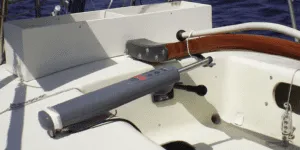The tiller on Tosca was rough-hewn piece of sawn ash, tough and springy. Where it fit in your hand it was about as big around as a teacup.The William Atkin ketch was built in 1937, and I liked to believe our tiller was the very same one she was born with—that this was the last piece of timber the builder had shaped, carefully hewn from a tree he had known as a boy, endowed with hidden magic.
It hadn’t always been varnished. The grain where you gripped it was worn smooth by so many hands. One year, I stripped down the old varnish. Looking closely, I could see what looked like finger-shaped depressions left by hands that had come before mine.
Years later, long after I’d sold the boat that had carried my partner and I across the Pacific, I was on a trip to New York City, and in one of those flashes that exposes the quirks of memory, I thought of the tiller again. There in the soft paws of Patience, one of the New York Public Library’s two guardian lions (the other is Fortitude), I found traces of countless caresses, fingerprints in stone, and realized that embarking upon a voyage—a proper voyage, one that is undertaken for all the right reasons—is not unlike sculpting marble: at once a carving-out and a filling-in. And I suppose that is why I’ll always favor a tiller over a wheel. Like the sculptors favorite chisel, it is a tool far better suited for the art of sail.

Tosca’s boats barn-door rudder had the hydrodynamics of a dumpster lid, but with a little effort the sails could be trimmed so that the helm sweetly balanced. In most conditions, when there was only a moderate sea for her to contend with, I could set my $1.69 autopilot—a single length of bungie cord, about two feet long, with a loop at one end, and figure-eight knots at intervals of four to six inches starting on the opposite side. The seaway, point of sail, or wind speed would determine which knot to use to apply the required tension.
A similar system worked with the Aries windvane. On the bottom of the tiller was a simple bronze chain hook. A small length of chain connected the two steering lines. To adjust the steering lines you would move the chain one link in either direction as needed. In the tradewinds, we could sail for days without touching a link.
But these practical conveniences are peanuts compared to the real payoff of having a tiller. I remember that even when the self-steering vane was holding a course far better than I could do, the temptation to feel Tosca respond to my touch, (and my touch respond to her motion) was irresistible. The real test came at night—for we had no wind instruments—when we steered by the wind on the back of our necks and the motion of the sea. It was then, sailing almost blind on a moonless night, that I recognized how intuitive my helming had become.
In plainest technical terms the tiller gives us corrective feedback, an opportunity to learn from our mistakes far quicker than any wheel assembly can do. Both devices help us become better sailors, but the tiller just does it faster. It is, at its core, more honest about the conditions were facing—sometimes brutally so.

After thousands of corrections, countless pushes and pulls to adjust for subtle wind shifts or insistent nudges of steep following seas, our intuition takes over. Where before each subtle course change involved a conscious effort, the thought and the act become one and the same. There are few things as satisfying as looking back at your wake, and noticing how the course you’ve drawn across the surface of the ocean, appears nearly perfect, as if it, too, was drawn by natural forces independent of the hand of man. The carving out of the sea is the filling-in of the tillerman.

































Tiller all the way. Amen.
My sailing experience has always been with tillers, but many years ago, mid 1960s, I was in the US Navy stationed on a destroyer, built during WW-2. I stood many wheel watches and learned to feel what the ship was doing and compensating became automatic. I would feel the stern start to lift in a following sea and without thinking would turn the wheel to keep her on course. My duty station during special sea detail (leaving and entering port, refueling and replenishing at sea) and when we were at general quarters was helmsman. Your article triggered the memories, and I can still feel the Philip’s response to my steering. Thanks for the memories!
The only good varnish on my F-24 is the tiller. I keep it covered and perfect. I take and the attached rudder home annually for paint and tune-ups. I’ve had a wheel on other boats, but it’s not the same–I used the autopilot most of the time on those. I have tiller extensions but don’t often use them. I’d rather rest a hand on the tiller.
The only thing I like about my wheel is the fact I can mount my instruments to a rotating pod on top of the pedestal. Otherwise it is heavy stuff located in an inconvenient spot taking up tons of room in the cockpit and complicating movement, especially with tethers, harness and PFDs getting in the way. I would love to convert but, on my boat, it is going to be costly to do a properly engineered removal/replacement.
For smaller vessels ( say 35 feet or less) a tiller is the way to go IMO.